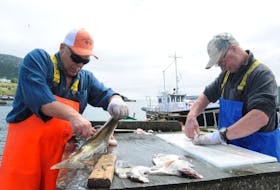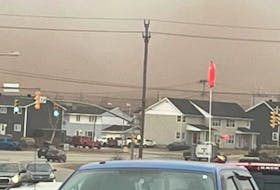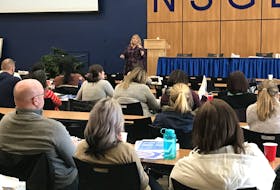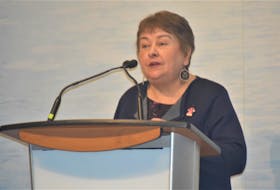
Fishers, plant workers, businesspeople and residents of all backgrounds, from the tip of the Northern Peninsula, together, unified in their concern about the uncertain future of the northern cod fishery.
With two caskets planked firmly on their shoulders, a group of fishermen led the way as demonstrators marched on West Street. The procession symbolized the death of the fishery.
At that time, federal Fisheries Minister John Crosbie had only indicated that a review of the northern cod would take place in early July. But the writing was on the wall.
On July 2, the announcement of the moratorium made it real.
Preparing for the summer
Dan Reardon of Goose Cove was one of the fishermen leading that procession on June 16.
As he reflects back on those days, some parts of the timeline are difficult to piece together for him now – everything had happened so fast and the events tend to blur together as the years accumulate and they recede in the memory.

The 65-year-old, now recently retired, can remember working in his shed that year. He says they knew something bad was coming, but a total closure of the cod fishery was unthinkable.
As June crept by and they waited and waited to get back on the water, the fishers in Goose Covewere occupied preparing their vessels and their gear. Reardon had even made a Japanese cod trap to use for the first time – one he says he never did get to use.
Empty Nets: The Cod Moratorium 25 years later
He can remember the radio playing in the shed during the day and their eyes were glued to the TV set in the evening, as they waited for some news – things weren’t looking great, and the nerves were growing, but they kept to work.
Then the worst possible news hit.
July 2, 1992
It was hard to accept.
“In the back of your mind, you’re thinking, ‘They’re not going to do that,’” says Reardon, reflecting back on what he was feeling when the moratorium was made official.

Reardon had fished cod since he was a teenager in the 1960s. It was impossible to overstate how life changing the moratorium was for people like him on the Northern Peninsula.
Bern Bromley was the mayor of St. Anthony from 1989 to 1993 and the publisher of the Northern Pen at the time. When the announcement was made, he says nobody knew how long the moratorium was going to be and what kind of compensation they were going to get.
He recalls the high level of anxiety this caused within the town.
“For the first couple of weeks, everybody was just mesmerized,” he says. “You had the feeling that the fishery was dead and that’s it.”
Who knew what was next?
According to Reardon, they were left feeling“pretty desperate.” He notes they had lost the salmon fishery a few months before that and it would seem that this had left them with nothing. They couldn’t foresee the new lease on life they would get through the shellfish at that time.
He felt the compensation they eventually got wasn’t enough, though it increased later.
“You wouldn’t able to survive on it,” he says.
According to Bromley, the compensation packages eased the burden a bit, but it didn’t ease the uncertainty about the fishery.
The lasting impact
For Bromley, the moratorium had planted the seed of the idea that the fishery wasn’t something you wanted to get into. Henceforth, it would be harder to attract younger generations to the fishery, especially as the world opened up and more and more sought greener pastures elsewhere.
Furthermore, while there were ups and downsin the fishery throughout the ‘80s, a sense of optimism about the future of the community persisted in St. Anthony, says Bromley. In some sense, the future they were hopeful for back then was never achieved due to the moratorium.
The local economy would never grow to where it could have with a vibrant cod fishery.
The mentality of the people had forever changed.
“The moratorium sort of forced us to say, ‘How can we hang on?’” explains Bromley.
Further down the coast in the Gulf – where the cod moratorium came a little later, in 1993 –current Port Saunders Mayor Carolyn Lavers perceives that, in general, the social fabric of the communities on the Northern Peninsula – though not necessarily all – has changed drastically.
“I don’t know if this has happened in every community but, here, we do not have the same social network as we were accustomed to and as I remember,” she says. “We have lost our community spirit.”
She attributes this in part to various technological affectsm but also to the economic instability after losing the cod fishery.
“(It) was disappearing but the moratorium kinda nailed it,” she says.
On the Northern Peninsula, there was never any going back to the days prior to 1992 and 1993.
Meanwhile, Reardon maintains there was some truth behind the symbolic gesture of the caskets they carried on that June 1992 day in St. Anthony.
“(The fishery) never died,” he says. “But it got pretty sick.”
25 years later
In a few years following the moratorium, the shellfish had become the predominant fishing industry on the Northern Peninsula: the crab and the shrimp, particularly, had replaced the cod.
In the St. Anthony area, they managed to get a new shrimp allocation and a new plant, saving some of the jobs.
“The shellfish sove (sic) us,” says Reardon. “Only for that, the outports would have been finished.”
But, today, the future in some respects seems to be repeating itself as the situation with the crab and the shrimp grows increasingly precarious in the province.
The future looks bleak to Reardon. In fact, after about 50 years in the fishery, he retired from it full-time this year, saying he got fed up with the management of the industry.
He has a hard time seeing much of a future in the shellfish given the recent quota cuts.
“It don’t look promising, I tell you that,” he says. “It looks like the crab fishery, in another year or so, is going to be a thing of the past.”
And, while he says he’s never seen the cod so plentiful as it is now, he’s concerned that once the crab and shrimp fisheries are gone, the cod will be overfished once again.
“Once the boats have nothing else to survive on, the pressure is going to be put on the government to go at the cod,” says Reardon. “And government – being political, they don’t care about the stocks – with the pressure put on them, they’re going to open it up.”
He believes it could be a matter of five to six years and the cod will be fished away all over again.
For these reasons, plus the shortness of the fishing season now, Reardon feels the situation looks more dire in the long-term than in 1992.









